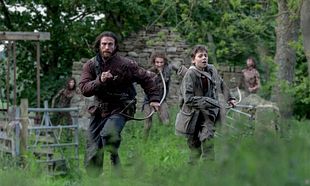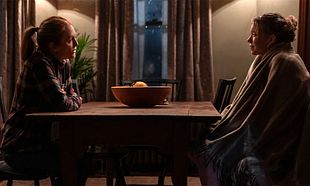An MI6 agent (Charlize Theron) is sent to Berlin days before the fall of the Berlin Wall, where she is ordered to make contact with a fellow MI6 agent (James McAvoy) and recover a stolen list of double-agents working in Europe and get a Stasi informant across the Wall.
From the very opening sequence, Atomic Blonde makes it clear that it's a film about flashiness, veneer and excess - just like the decade in which it's set. Charlize Theron's character is dressed from head-to-toe like a fashion model - even though she's supposed to be an undercover agent. James McAvoy's character careens around Berlin in a black Porsche 911 whilst blasting out synthpop hits - even though he's supposed to be MI6's man in Berlin. Even more pointedly, Theron's hotel room in Berlin has actual neon for illumination and looks like Giorgio Moroder's dressing room. It completely glamourises and fetishises the decade from the outset and just oozes style out of every scene, but what's underneath it all?
Charlize Theron's performance is all physical, taking part in bone-crunching fight sequences with a real enthusiasm that proves she's more than capable of holding her own with the likes of Keanu Reeves or a latter-day Harrison Ford. Like David Leitch's previous effort, John Wick, it's all done in camera with few cuts and edits for stunt players. You can see Theron bouncing henchmen off walls, taking kicks and punches, and - in one hilarious sequence - making an escape with a garden hose wrapped around a German police officer's neck, all to the sounds of George Michael's 1987 hit single Father Figure. Really. James McAvoy, meanwhile, serves as the sure-not-if-he's-the-antagonist, whilst Sofia Boutella turns up as the love interest for Theron. You've also got John Goodman as a CIA official, Toby Jones as Theron's MI6 handler, and Eddie Marsan as the Stasi informant in there, too.
For the most part, the cast are well chosen and do their best, but it's the script from 300 scribe Kurt Johnstad that completely lets down Atomic Blonde and prevents it from being everything you hoped it could be. While most spy thrillers are complex and labyrinthine in nature, Atomic Blonde isn't smart or deep enough to carry it off. More to the point, the constant presence of plot just serves to slow down the film altogether. The film works best when you park the script and stop trying to follow the dizzingly, overblown plot. Sure, it's a film about spies and double-crosses in Berlin, but the screenplay handles them all in such a cack-handed way that you'll either go daft trying to keep along with it, or just give up and reject it outright.
David Leitch's use of music echoes Edgar Wright's Baby Driver, coming into play with precision and poise - and sometimes with comedic effect. As you'd expect from one of the directors of John Wick AKA The Greatest Action Movie Of The Decade™, Leitch knows how to block and shoot an action scene - and this is the real strength of Atomic Blonde. The fight choreography, the stunt work, the car chases, the choice of music and the cinematography all coalesce together to create something brutally effective. It's no wonder that Leitch is now one of the most in-demand action directors working today, and Atomic Blonde is more proof as to why that is. Cinematographer Jonathan Sela, who was a student of the great Vilmos Zsigmond, knows how to make each shot and scene look slick and polished, calling to mind Nicolas Winding Refn's The Neon Demon in parts.
Overall, Atomic Blonde is a superior action movie, features a fantastic soundtrack and has a strong lead performance from Theron - all of which makes up for a weak script.



















































































